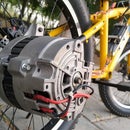Introduction: DIY Portable Power Inverter (12v DC to 220v AC)
In this instructable I am going to built a portable power inverter that converts 12v DC TO 220v AC. This is probably the smallest portable homemade inverter you will find here. The goal is to built this inverter to fulfil the need of having a line voltage on your work bench that is far away from any power outlet.
This power inverter is able to deliver 70 watts of continuous power which is good enough for small appliances such as a hot glue gun or a soldering iron.
For more projects don't forget to visit and subscribe to my youtube channel:
Regards.
DIY King
Step 1: Required Stuff
The material that is required for this project is listed below:
- A 12v old computer fan
- Lithium polymer cells (Mine are from an old laptop battery)
- A power inverter circuit
- A multi pin socket
- A switch and charging jack
- A bunch of wires
- Rubber pads
- Plexi glass sheet
Step 2: Main Case Parts
The sides of the main casing/housing are made out of 5mm thick plexi glass sheet,their dimension are as follows:
- 100mm*65mm (2 pcs)
- 100mm*57mm (2 pcs)
The front and rear plates are made out of 4mm thick fibre glass sheet having the dimensions:
- 65mm*65mm (2 pcs)
A 2 inch hole is drilled in the fibre glass sheet using a hole saw to attach the cooling fan to it.
Step 3: Battery Pack
The battery pack is a 12v 2200mAh made out of three lithium polymer cells each having a voltage of approximately 3.7 volt.
First all three cells are glued together and then all of them are connected in series.
Step 4: Power to Inverter
The battery pack is then connected to the inverter input side. The white wire indiates the negative terminal that is directly soldered to the inverter while the positive wire from the battery goes through the switch and then soldered to the inverter.
Step 5: Attaching the Battery Pack and Circuit
Now the battery pack and the inverter in mounted to the plexi glass sheet using double sided tape.
Step 6: Side Plates Ventillation
In both the side plates I have drilled six holes each measuring 10mm in diameter. These holes allow the incoming air from the cooling fan to escape from within the inverter.
Step 7:
The switch for the inverter, the led indication light and the charging jack are all mounted to the top plate. So the first thing is to make cavity for all of them. Multiple holes are drilled in the plexi glass sheet and then each hole is expanded up to the required size.
All the things sits perfectly within their respective cavities.
Step 8: Socket Cavity
The output socket sits on the front plate and to do so we need to make a cavity for the socket. First the pattern is drawn and then multiples small holes are drilled along with that boundary. Later the edges are sanded for a claer fitting.
Now four mounting holes are drilled to mount the socket. The socket is then mounted to the front plate.
Step 9: Wiring Everything Together
First the charging jack is soldered. The centre wire is positive while the other one is negative.
Now the positive leads from the fan and the inverter are soldered together and then soldered to one of the terminals on the switch.
While the positive wires from the battery and the charging jack are soldered together and then soldered to the other terminal of the switch.
A negative wire from the charging jack is then soldered to the negative terminal of the battery pack.
Each connection is then secured using a heat shrink tubing.
Step 10: Gluing the Case
Now each side of the case is glued together while the front and rear plates are glued there after insuring that the wires are properly placed away from moving fan.
Later the rubber pads are glued to the base plates.
Step 11: Final Results
The end results are satisfying since the overall unit is very small and attractive and have good amount of power that is around 70 watts. The battery lasts for around 20 mins at maximum power.
This seems to be a very useful gadget for electronic workbench where there is no power around. The best part about this project is that it uses very common parts and costs around 5 USD.
Regards.
DIY King




